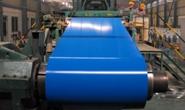Market Data

November 2, 2017
Prepaint Buyers Ponder Price Hikes
Written by Tim Triplett
With the notable exception of AkzoNobel, leading suppliers of paint and coatings to the prepaint market have announced price hikes of 5-7 percent, effective in January. And some coil coaters and their customers are not happy about it.
One prepaint buyer who closely tracks raw material costs questions whether the current hike is justified. “While materials, particularly titanium dioxide, have risen this year, chemicals used in paint are not back to the levels they were in 2014 when the paint companies had their last price increase. Chemical costs dropped significantly in 2015 and 2016. Paint companies never decrease prices, they only raise prices,” he said.
![]() “I am having a hard time figuring out how these increases are justified,” said a like-minded coil coater. “The last increase was when oil was over $100 per barrel. Now that oil is back to the mid-$50s, there has been an increase in raw material? There was no decrease when oil dropped to the low $40s. They seem to be ignoring the prior drop in raw material costs. Paint prices have never gone down,” he noted.
“I am having a hard time figuring out how these increases are justified,” said a like-minded coil coater. “The last increase was when oil was over $100 per barrel. Now that oil is back to the mid-$50s, there has been an increase in raw material? There was no decrease when oil dropped to the low $40s. They seem to be ignoring the prior drop in raw material costs. Paint prices have never gone down,” he noted.
Some paint companies got overly aggressive with rebates to end users and service centers in an attempt to gain market share and are now paying the price, he said. “They are pushing for a price increase to cover their aggressive market approach.”
Caught in the middle are toll coaters. “We know of one coater who has told the paint companies he will not pay any paint price increase until they get a signed letter from the end user accepting the increase,” the source told SMU.
Some toll coaters see an opportunity to raise pricing along with the paint companies. Their increases are not modest at 5-9 percent, the source said, which can amount to $20 to $45 per ton depending on the paint system.
At least one distributor feels the paint companies are somewhat justified in hiking prices, since their last increase was fully three years ago. “Because prepainted import pricing has increased substantially in the past few years, many feel this increase will be accepted with little impact on the market,” he said.
Valspar Corp., as the largest supplier to the domestic prepainted industry, has been the primary driver of this increase, the distributor said. Sherwin-Williams acquired Valspar earlier this year. Perhaps Sherwin-Williams believes Valspar is not making margins commensurate with its volume and market leadership role, he speculated.
AkzoNobel, the second largest supplier, is not participating in the announced increase at this time. “The increase is being driven by the largest supplier with the second largest supplier abstaining, so there could be some jockeying for business. But most people feel Akzo will just announce its increase to take effect a bit later in the year. There really is no reason for them not to move with the market,” the distributor said. AkzoNobel may be otherwise occupied as it is in merger talks with Axalta Coating Systems. Akzo spurned a merger offer from PPG Industries earlier this year.
The distributor points to another change in the market that could have ramifications beyond the recent price hike. AkzoNobel, Beckers, PPG and Valspar have started supplying the same quality of paint warranted to several of the Korean, Taiwanese and Vietnamese integrated suppliers (flat rolled producer and coil coater). The U.S. supply base has long touted their superior quality and warranty support as the rationale for charging customers more than they pay for imports. Now buyers will be able to get the same product from foreign sources, which could add to the pricing pressure on domestic prepainted products, he said.
Written by Tim Triplett, Tim@SteelMarketUpdate.com







